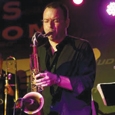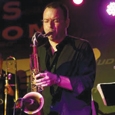After teaching privately and at the college level for many years, a common struggle among my students is rhythm. Another disturbing trend is how few students listen to jazz legends to discover how great rhythm or time should sound.
A student must discover and emulate the rhythmic feel he desires. As a student, I carefully analyzed the rhythmic feel of my favorite saxophonists. I admired Dexter Gordon’s ability to lay far behind the beat and loved Michael Brecker’s seemingly perfect rhythm. I would often learn and perform transcriptions while recording myself in order to analyze my accuracy. In addition, transcribing jazz solos helped me to develop tone, articulation, vibrato and how to shape the emotional aspect of my performances.
Besides emulating my favorite musicians, I also use a metronome to emphasize beats two and four by setting it to half the tempo I want. Using a metronome this way mimics the sound of the high hat on a drum kit. For example, try playing major scales to the ninth degree using jazz articulation at 60bpm (this translates to 4/4 at 120bpm). Then, try to swing with the metronome without switching to beats one and three.
Setting the metronome so it only clicks on beat one is extremely effective for practicing fast tempos, as it eliminates potential anxiety hearing all four. It can be difficult at first, but I encourage my students to fight through the frustration.
After scales, try to play a medium-swing melody like Duke Ellington’s Satin Doll using the metronome on two and four. Also, have students try to tap their foot on two and four to physically internalize the rhythmic pulse. A saxophone player could then try to emulate the style of Ben Webster, copying his time, tone, vibrato, and articulation. Students can learn much by listening to recordings of this process. Eventually, a serious jazz student will need to turn off the metronome and attempt to swing relying on his internal sense of time.
Young students should seek out performance opportunities whenever possible to develop these concepts. Often these are found in academic ensembles, but they can also occur outside of school. It just isn’t enough to practice in the safety and privacy of home. A student has to summon the bravery to perform publicly and learn from mistakes.






